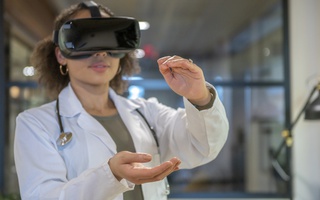Creating software simulations of the human brain is considered the most promising approach to artificial intelligence.
The Australian startup Cortical Labs has gone even further: it aims to create a minuscule artificial brain by embedding biological neurons of mouse or human origin into a specialized computer chip.
This company, headquartered in Melbourne, Australia, strives to teach the hybrid brain to perform the tasks of artificial intelligence with much better energy efficiency and effectiveness. It is now creating an artificial brain with a computational power close to a dragonfly's brain and wants to teach it the old arcade game Atapi Pong. And this is just the beginning.
Teaching the hybrid brain to play Atapi Pong is an important milestone, as this was one of the games played by the DeepMind neural network (one of the AI system development pioneers) at the time when it caught the interest of Google.
Cortical Labs uses two methods to create its hardware: it either extracts mouse neurons from embryos or converts human skin cells back into stem cells and then cultures neurons from them.
The produced neurons are placed in a nutrient liquid medium on top of a special metal oxide chip containing a grid of 22 thousand tiny electrodes. These electrodes are used to input and output data. At present, mouse neurons are being used for "Pong" research.
In perspective, Cortical Labs aims to leverage hybrid chips to find the clue to more advanced inferencing and conceptual understanding unavailable for modern AI. Such biological neural networks have self-organizing capabilities empowering them to solve problems in unknown situations and without reference to the knowledge already acquired.
The Cortical Labs methodology, if successful, may potentially solve one of the most daunting challenges of machine learning: very high power consumption.
For example, AlphaGo, DeepMind's deep learning system designed to play an ancient strategic game of go, defeated the world's best human player back in 2016. However, Ceva estimates that it consumed 1 megawatt of power during the game, which is equivalent to the daily consumption of about 100 houses. At the same time, the human brain consumes about 20 watts of power, which is 50,000 times less than the AlphaGo.
The use of biological neurons also eliminates a number of other difficulties intrinsic to programmable neural networks. For example, a prerequisite for productive learning of neural networks is that their programmers must manually set the baseline coefficients that will then be applied to each data type. Another problem is to force the neural network to try to find new solutions to the problems without relying on already existing practices. A separate issue is the inability of modern AI to make inferences in unknown situations without having a sufficient amount of preset data.
Cortical Labs initially experiments with mouse neurons that have long been used by neurobiologists as substitutes for human neurons. The methods of their extraction and cultivation have been known for a long time while creating human neurons from skin cells was mastered only in the last decade. However, scientists have recently discovered differences in the surface proteins of mouse and human neurons, which may mean that they have different electrical properties and cannot fully replace each other.
Some aspects of the Cortical Labs system are inspired by the theories of Karl Friston, an English neuroscientist who worked on the self-organization of biological systems and the free energy principle. This concept is based on the idea that the anatomy of any system contains a model of the environment in which the system is immersed and the data that it processes. Karl Friston appreciated the potential of Cortical Labs solution.
Cortical Labs is not the only company specializing in biological computing. Koniku, a Californian startup, has developed a 64-neuron silicon chip built using mouse neurons. The chip is able to recognize certain chemicals and distinguish between them. The company plans to develop military drones to detect explosives.
Article source: adapted from Fortun









